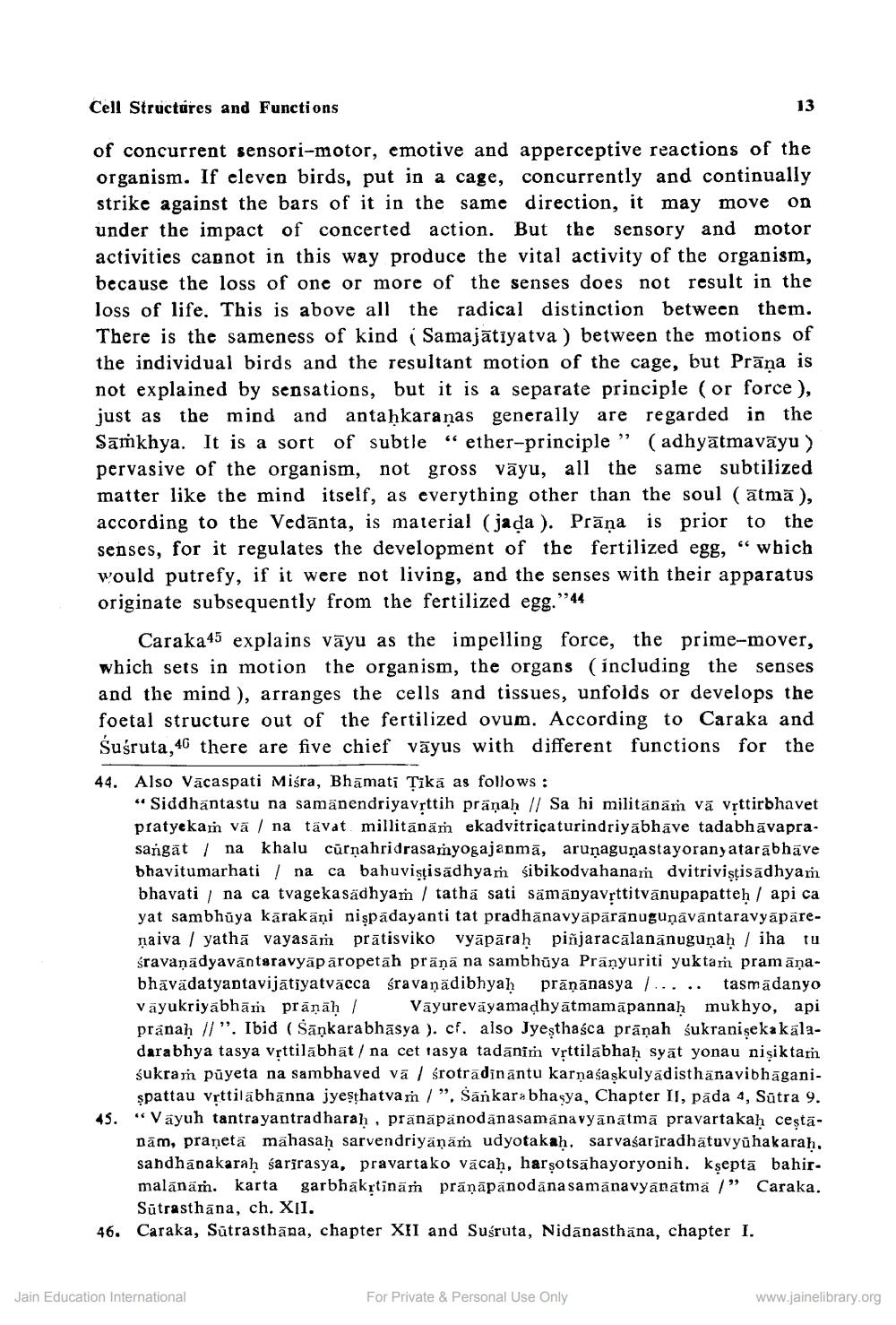________________
Cell Structures and Functions
13
of concurrent sensori-motor, emotive and apperceptive reactions of the organism. If eleven birds, put in a cage, concurrently and continually strike against the bars of it in the same direction, it may move on under the impact of concerted action. But the sensory and motor activities cannot in this way produce the vital activity of the organism, because the loss of one or more of the senses does not result in the loss of life. This is above all the radical distinction between them. There is the sameness of kind i Samajātiyatva ) between the motions of the individual birds and the resultant motion of the cage, but Prāņa is not explained by sensations, but it is a separate principle (or force ), just as the mind and antahkaranas generally are regarded in the Samkhya. It is a sort of subtle “ether-principle" (adhyātmavāyu ) pervasive of the organism, not gross vāyu, all the same subtilized matter like the mind itself, as everything other than the soul (ātmā), according to the Vedānta, is material (jada ). Prāņa is prior to the senses, for it regulates the development of the fertilized egg, “ wbich would putrefy, if it were not living, and the senses with their apparatus originate subsequently from the fertilized egg.”:44
Caraka45 explains vāyu as the impelling force, the prime-mover, which sets in motion the organism, the organs (including the senses and the mind ), arranges the cells and tissues, unfolds or develops the foetal structure out of the fertilized ovum. According to Caraka and Susruta,46 there are five chief vāyus with different functions for the
44. Also Vācaspati Misra, Bhāmati Țikā as follows:
“ Siddhantastu na samanendriyavrttih prāņah // Sa hi militanam vă Vrttirbhavet pratyekam vā/ na tävat millitānām ekadvitricaturindriyabhāve tadabhāvaprasangāt / na khalu cūrņahridrasamyogajanmā, aruņagunastayoranyatarābhāve bhavitumarhati / na ca bahuvistisādhyam sibikodvahanam dvitriviştisadhyam bhavati / na ca tvagekasädhyam / tatha sati sämânyavrttitvānupapatteh / api ca yat sambhūya karakāni nişpadayanti tat pradhanavyāpārānuguņāvāntaravyāpāreņaiva / yathā vayasām prātisviko vyāpāraḥ piñjaracālanānuguṇaḥ / iha tu sravanadyavántaravyāpāropetah prāņā na sambhūya Prānyuriti yuktam pramāņabhāvadatyantavijātiyatvācca śravaņādibhyah prāņānasya 1..... tasmädanyo Vāyukriyabhām prāņāh/ Vayurevāyamadhyātmamāpannah mukhyo, api pranah 1". Ibid (Sāņkarabhāsya ). cf. also Jyeșthasca prāṇah sukranişeka kaladarabhya tasya Vịttilābhāt / na cet rasya tadanim Vsttilabhah syāt yonau nişiktam sukram pūyeta na sambhaved vā / śrotradināntu karņaśaskulyadisthanavibhāganispattau Vrttilābhānna jyeșthatvam/". Sankara bhasya, Chapter II, pada 4, Sūtra 9. “Vayuh tantrayantradharah , prānāpänodānasamânavyānātmā pravartakah cestanām, praneta mahasah sarvendriyāņām udyotakah, sarvagariradhātuvyūhakarah, sandhānakaraḥ śarīrasya, pravartako Vācah, harşotsāhayoryonih. kşeptā bahir. malānām. karta garbhakrtīnām prāņāpānodana samanavyānātma / ” Caraka.
Sūtrasthāna, ch. XI. 46. Caraka, Sūtrasthāna, chapter XII and Susruta, Nidānasthāna, chapter I.
Jain Education International
For Private & Personal Use Only
www.jainelibrary.org




